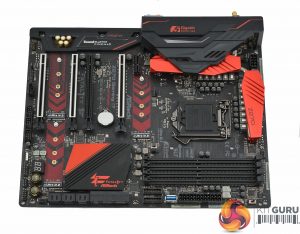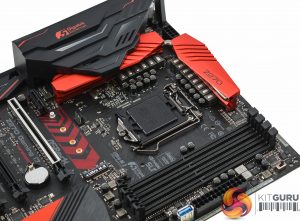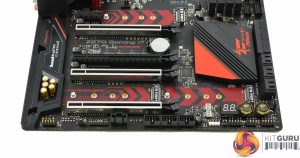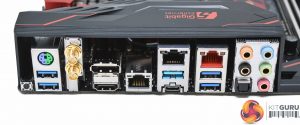So many motherboard brands have moved away from red and black towards neutral colours for gaming motherboards that the ASRock Fatal1ty Z270 Professional Gaming i7 is almost unique again simply by sticking with it. Red and black has long been the chosen colour of Fatal1ty range so there's certainly nothing wrong with ASRock the theme to maintain its brand identity.
ASRock offers RGB capability through its AURA package which entails three independent lighting zones onboard – the PCH heatsink, audio section and rear I/O shroud. It's also possible to add an RGB strip to the provided 12v G R B header.
Overall the presentation and aesthetic of the Fatal1ty Z270 Gaming i7 is smart and well-executed – we think it's an improvement over ASRock's styling efforts on the Fata1lty X99 Gaming i7.
Running along the side of the motherboard there are ten SATA ports, four of which shared with two SATA Express ports, two USB 3.0 headers and a vertical Type-A USB 3.0 port. ASRock places an XMP switch by the memory lanes which is a tad gimmicky given you can easily enable XMP from within the UEFI.
Strangely the fan header designed CHA_FAN3/W_PUMP is the fan header located furthest away from the CPU socket. ASRock hasn't really thought about the placement since the vast majority of users will have water pumps from AIOs, not custom loops, and thus the pump is close to the CPU socket.
ASRock did a similar thing with the Z270 Extreme4, marking the fan header near the front panel I/O as the W_PUMP one. In practice you can use any fan header for your pump so it's certainly not a deal breaker.
The power delivery system on this board uses an 8+4+2 (CPU+iGPU+VCCSA/VCCIO) phase design for a total of 14 phases. This is a little better equipped than some of the competition, such as the MSI Z270 Gaming M7, and the overall quality of the components is high with the use of 60-amp power chokes (inductors) and Nichicon 12K-rated capacitors.
Overall this is a strong power solution and is well-placed to hold stable those long-term overclocks.
Connectivity at the base of the motherboard includes an ample three USB 2.0 headers, a 12v G R B header for LED strips, power & reset buttons and a debug code reader.
Note that ASRock no longer has swappable UEFI BIOS chips since they are soldered to the board, but there are two so they can be used for recovery and failover.
Three of the PCIe x16 lanes are shielded with the intention that graphics cards should be used in these slots. You can populate all three with AMD GPUs for up to 3-way CrossFireX or 16x slots 1 and 3 for up to Nvidia 2-way SLI. As mentioned previously you can get x16/x0/x0, x8/x8/x0 or x8/x4/x4 when using 1, 2 or 3 GPUs in these shielded slots.
The three M.2 slots are well placed in and around the PCIe lanes to the point where no connectivity is obviously lost to make room for these. ASRock has managed to shrink the size of the PCH heatsink to find some of this extra space. All three M.2 slots support the maximum size of 11cm and all will perform up to 32Gbps through NVMe. However, if all three M.2 slots are populated you will end up losing five of the ten total SATA ports of which all of those 5 are the chipset-powered SATA ports. This perhaps explains why ASRock felt compelled to add the ASMedia SATA controller to provide additional SATA ports.
The logic with three M.2 slots, at the expense of any U.2, is also a well-grounded one in that you can convert M.2 into U.2 easily with an adapter, but not the other way around.
The audio solution is a standard Realtek ALC1220 package, which includes a headphone amplifier (Texas Instruments NE5532), implemented on an isolated PCB and married to high quality Nichicon Fine Gold series audio capacitors.
The rear I/O is networking heavy with three Ethernet ports and wireless antennae, this means there's been less space for USB ports. In total you get just four USB 3.0 ports and two USB 3.1, of which one is type-C. ASRock does, however, provide PS/2 for overclockers and general users who have a penchant for old peripherals.
- 2 x WiFi Antenna Ports
- 1 x PS/2 Mouse/Keyboard Port
- 1 x HDMI Port
- 1 x DisplayPort 1.2
- 1 x Optical SPDIF Out Port
- 1 x USB 3.1 Type-A Port
- 1 x USB 3.1 Type-C Port
- 3 x USB 3.0 Ports
- 1 x Fatal1ty Mouse Port (USB 3.0)
- 3 x RJ-45 LAN Ports with LED
- 1 x Clear CMOS Switch
- 5 x HD Audio Jacks
Underneath the motherboard are a selection of Philips-head screws which make for easy disassembly and maintenance of the motherboard for watercooling and overclocking enthusiasts.
 KitGuru KitGuru.net – Tech News | Hardware News | Hardware Reviews | IOS | Mobile | Gaming | Graphics Cards
KitGuru KitGuru.net – Tech News | Hardware News | Hardware Reviews | IOS | Mobile | Gaming | Graphics Cards













Might just grab this one, and Im thinking to get the next 580 Red Devil, will be a very good devilish looking match 😀
It’s damn beautiful mobo, just got time last wk.. you cannot go wrong.
Regarding the questionable fan/water pump header location. There is one right under the power 8pin connector. The one at the bottom could be used for another water cooling circuit (GPU).